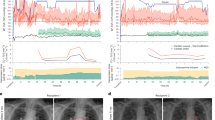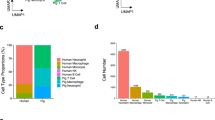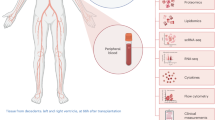Abstract
Genetically engineered pig lungs have not previously been transplanted into humans, leaving key questions unanswered regarding the human immune response in the context of a xenotransplanted lung and the possibility of hyperacute rejection. Here, we report a case of pig-to-human lung xenotransplantation, in which a lung from a six-gene-edited pig was transplanted into a 39-year-old brain-dead male human recipient following a brain hemorrhage. The lung xenograft maintained viability and functionality over the course of the 216 hours of the monitoring period, without signs of hyperacute rejection or infection. Severe edema resembling primary graft dysfunction was observed at 24 hours after transplantation, potentially due to ischemia–reperfusion injury. Antibody-mediated rejection appeared to contribute to xenograft damage on postoperative days 3 and 6, with partial recovery by day 9. Immunosuppression included rabbit anti-thymocyte globulin, basiliximab, rituximab, eculizumab, tofacitinib, tacrolimus, mycophenolate mofetil and tapering steroids, with adjustments made during the postoperative period based on assessments of immune status. Although this study demonstrates the feasibility of pig-to-human lung xenotransplantation, substantial challenges relating to organ rejection and infection remain, and further preclinical studies are necessary before clinical translation of this procedure.
This is a preview of subscription content, access via your institution
Access options
Access Nature and 54 other Nature Portfolio journals
Get Nature+, our best-value online-access subscription
$32.99 / 30 days
cancel any time
Subscribe to this journal
Receive 12 print issues and online access
$259.00 per year
only $21.58 per issue
Buy this article
- Purchase on SpringerLink
- Instant access to full article PDF
Prices may be subject to local taxes which are calculated during checkout






Similar content being viewed by others
Data availability
These data are not publicly accessible due to ethical and institutional restrictions safeguarding research subject privacy. De-identified recipient data supporting the findings of this study are available upon request from the corresponding author, subject to ethics and institutional approval. Requests will be reviewed within 2 weeks.
References
Chisholm-Burns, M., Kelly, B. S. & Spivey, C. A. Xenotransplantation could either be a friend or foe of healthcare equity. Commun. Med. (Lond.) 4, 85 (2024).
Mohiuddin, M. M. et al. Graft dysfunction in compassionate use of genetically engineered pig-to-human cardiac xenotransplantation: a case report. Lancet 402, 397–410 (2023).
Mallapaty, S. & Kozlov, M. First pig kidney transplant in a person: what it means for the future. Nature 628, 13–14 (2024).
Wang, Y. et al. Pig-to-human kidney xenotransplants using genetically modified minipigs. Cell Rep. Med. 5, 101744 (2024).
Burdorf, L. et al. Pig-to-baboon lung xenotransplantation: extended survival with targeted genetic modifications and pharmacologic treatments. Am. J. Transplant. 22, 28–45 (2022).
Li, Q. et al. Carbohydrate antigen expression and anti-pig antibodies in New World capuchin monkeys: relevance to studies of xenotransplantation. Xenotransplantation 26, e12498 (2019).
Bailey, J., Capaldo, T., Conlee, K., Thew, M. & Pippin, J. Experimental use of nonhuman primates is not a simple problem. Nat. Med. 14, 1011–1012 (2008).
Bharat, A. & Kreisel, D. Immunopathogenesis of primary graft dysfunction after lung transplantation. Ann. Thorac. Surg. 105, 671–674 (2018).
Kubicki, N., Laird, C., Burdorf, L., Pierson, R. N. 3rd & Azimzadeh, A. M. Current status of pig lung xenotransplantation. Int J. Surg. 23, 247–254 (2015).
Harris, D. G. et al. Lung xenotransplantation: recent progress and current status. Xenotransplantation 21, 496–506 (2014).
Pullen, L. C. Xenotransplantation moves toward clinical trials. Am. J. Transplant. 24, 509–511 (2024).
Whitsett, J. A. & Alenghat, T. Respiratory epithelial cells orchestrate pulmonary innate immunity. Nat. Immunol. 16, 27–35 (2015).
Griffith, B. P. et al. Transplantation of a genetically modified porcine heart into a live human. Nat. Med. 31, 589–598 (2025).
Snell, G. I. et al. Report of the ISHLT Working Group on Primary Lung Graft Dysfunction, part I: definition and grading – a 2016 Consensus Group statement of the International Society for Heart and Lung Transplantation. J. Heart Lung Transplant. 36, 1097–1103 (2017).
Montgomery, R. A. et al. Results of two cases of pig-to-human kidney xenotransplantation. N. Engl. J. Med. 386, 1889–1898 (2022).
Burdorf, L. et al. Thromboxane and histamine mediate PVR elevation during xenogeneic pig lung perfusion with human blood. Xenotransplantation 26, e12458 (2019).
Loupy, A. et al. Immune response after pig-to-human kidney xenotransplantation: a multimodal phenotyping study. Lancet 402, 1158–1169 (2023).
Estrada, J. L. et al. Evaluation of human and non-human primate antibody binding to pig cells lacking GGTA1/CMAH/beta4GalNT2 genes. Xenotransplantation 22, 194–202 (2015).
Anand, R. P. et al. Design and testing of a humanized porcine donor for xenotransplantation. Nature 622, 393–401 (2023).
Xu, H., Perez, S. D., Cheeseman, J., Mehta, A. K. & Kirk, A. D. The allo- and viral-specific immunosuppressive effect of belatacept, but not tacrolimus, attenuates with progressive T cell maturation. Am. J. Transplant. 14, 319–332 (2014).
Mavragani, C. P. Mechanisms and new strategies for primary Sjogren’s syndrome. Annu. Rev. Med. 68, 331–343 (2017).
Moazami, N. et al. Pig-to-human heart xenotransplantation in two recently deceased human recipients. Nat. Med. 29, 1989–1997 (2023).
Chen, J. Q. et al. Scan of the endogenous retrovirus sequences across the swine genome and survey of their copy number variation and sequence diversity among various Chinese and Western pig breeds. Zool. Res. 43, 423–441 (2022).
Chen, S. Ultrafast one-pass FASTQ data preprocessing, quality control, and deduplication using fastp. Imeta 2, e107 (2023).
Langmead, B. & Salzberg, S. L. Fast gapped-read alignment with Bowtie 2. Nat. Methods 9, 357–359 (2012).
Menown, I. B., Archbold, J. A., Bamford, K. B., Bell, P. M. & Callender, M. E. Community-acquired lower respiratory tract infection: implementation of an antibiotic protocol. Br. J. Clin. Pract. 51, 74–77 (1997).
Houtgast, E. J., Sima, V. M., Bertels, K. & Al-Ars, Z. Hardware acceleration of BWA-MEM genomic short read mapping for longer read lengths. Comput. Biol. Chem. 75, 54–64 (2018).
Goodacre, N., Aljanahi, A., Nandakumar, S., Mikailov, M. & Khan, A. S. A reference viral database (RVDB) to enhance bioinformatics analysis of high-throughput sequencing for novel virus detection. mSphere 3, e00069–18 (2018).
Kim, D., Paggi, J. M., Park, C., Bennett, C. & Salzberg, S. L. Graph-based genome alignment and genotyping with HISAT2 and HISAT-genotype. Nat. Biotechnol. 37, 907–915 (2019).
Liao, Y., Smyth, G. K. & Shi, W. featureCounts: an efficient general purpose program for assigning sequence reads to genomic features. Bioinformatics 30, 923–930 (2014).
Acknowledgements
We thank the family of the decedent for their invaluable contribution to the advancement of lung xenotransplantation and scientific research. We also thank the clinical and laboratory teams at the First Affiliated Hospital of Guangzhou Medical University and the National Clinical Centre for Respiratory Disease, including the lung xenotransplantation clinical team (Y. Zeng, J. Mao, L. Wang, W. Shen, J. Zhang, T. Xing, Y. Xue, J. Fan, Y. Ouyang and X. Zhang), the nursing team (Y. Chen, D. Huang, R. Li, X. Li, M. Kuang and X. Li), anesthesiologist Y. Zhou, laboratory staff (W. Wang, L. Liu, Z. Huang and M. Yu) and the organ procurement organization personnel (L. Wang, L. Wang, Y. Wang and K. Li) for their unwavering support. We acknowledge L. Burdorf and C. Laird’s team for their pioneering work on NHP lung xenotransplantation, which inspired this research, particularly in the experimental design.
Author information
Authors and Affiliations
Contributions
J.H., J.S., C.Y., G.P., C.J., H.L., P.H., X.L., Z.Z., C.C., D.P., Z.Y., W.G., H.T.L., Z.C., M.L., H.R.L., Y.Z., W.H., K.J., T.F.C.-Y., A.J.R., A.L., X.L. and X.X. contributed to the conception and design of the study. J.S., C.Y., G.P., C.J., H.L., P.H., X.L., Z.Z., C.C., D.P., Z.Y., W.G., H.T.L., Z.C., M.L., H.R.L., Y.Z. and W.H. performed the data collection and analysis. J.H., X.L. and X.X. supervised the project. J.H., J.S., C.Y., G.P., X.L. and X.X. drafted the manuscript, with critical revisions from J.H., K.Z., J.S., X.L., Y.Z., N.Z. and X.X. All authors reviewed and approved the final manuscript.
Corresponding authors
Ethics declarations
Competing interests
D.P. is a co-founder of Chengdu Clonorgan Biotechnology Co. Ltd, Chengdu, China. The other authors declare competing interests.
Peer review
Peer review information
Nature Medicine thanks Hidetaka Hara and Eckhard Wolf for their contribution to the peer review of this work. Primary Handling Editor: Michael Basson, in collaboration with the Nature Medicine team.
Additional information
Publisher’s note Springer Nature remains neutral with regard to jurisdictional claims in published maps and institutional affiliations.
Supplementary information
Supplementary Information
Supplementary Figs. 1–4 and Tables 1 and 2.
Rights and permissions
Springer Nature or its licensor (e.g. a society or other partner) holds exclusive rights to this article under a publishing agreement with the author(s) or other rightsholder(s); author self-archiving of the accepted manuscript version of this article is solely governed by the terms of such publishing agreement and applicable law.
About this article
Cite this article
He, J., Shi, J., Yang, C. et al. Pig-to-human lung xenotransplantation into a brain-dead recipient. Nat Med (2025). https://doi.org/10.1038/s41591-025-03861-x
Received:
Accepted:
Published:
DOI: https://doi.org/10.1038/s41591-025-03861-x
This article is cited by
-
Pig lung transplanted into a person in world first
Nature (2025)



